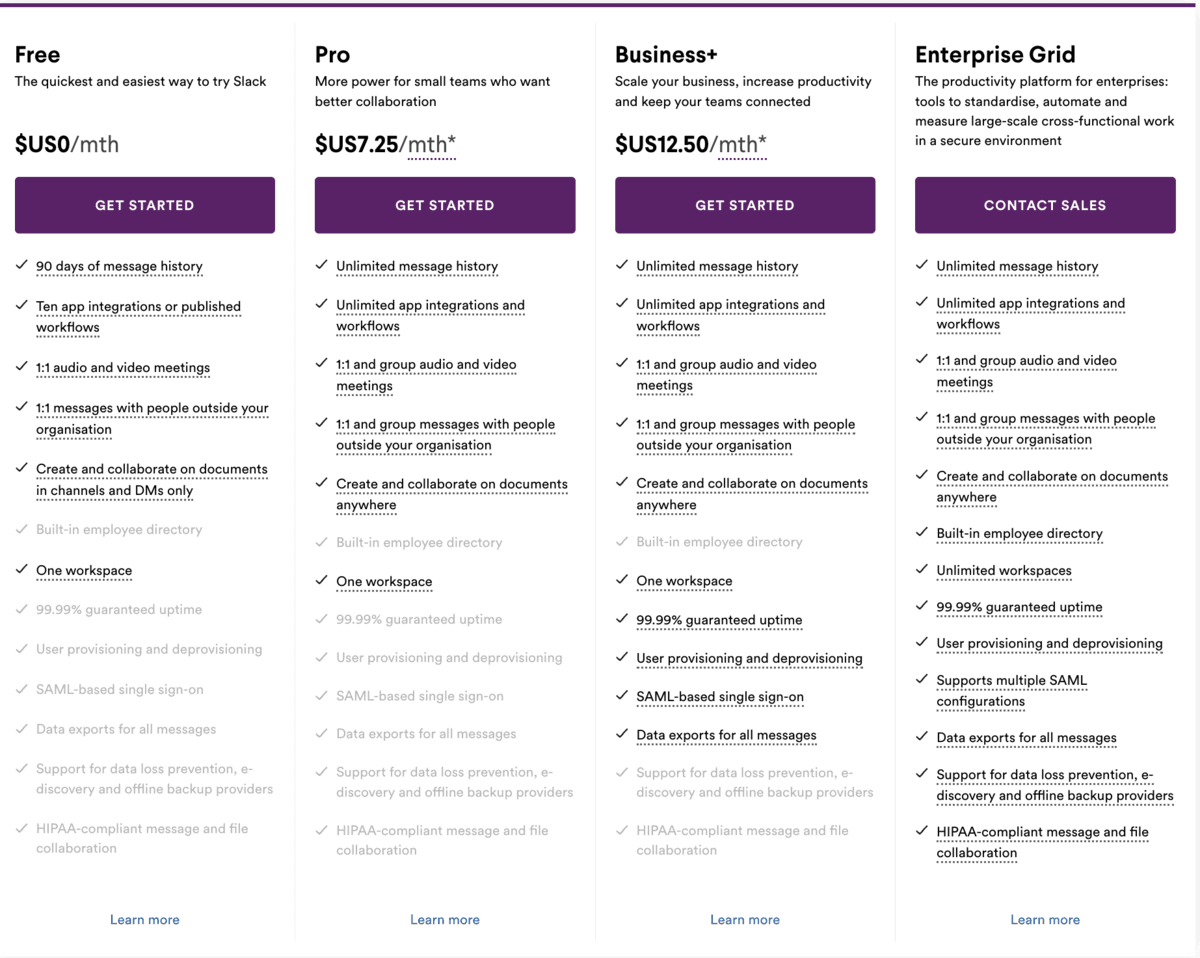Cara Menggunakan Strategi Penetapan Harga dengan Imbalan untuk Memaksimalkan Keuntungan Anda
Strategi penetapan harga digunakan oleh bisnis untuk menentukan harga terbaik untuk produk mereka. Baca blog ini untuk mempelajari teknik dan jenis penetapan harga.
Di halaman ini
Satu hal yang harus diperhatikan oleh sebuah bisnis adalah strategi penetapan harga. Harga tidak boleh terlalu rendah atau terlalu tinggi. Menetapkan harga yang optimal untuk produk melibatkan pertimbangan banyak aspek.
Meskipun ada banyak metodologi penetapan harga, yang Anda pilih harus sesuai dengan bisnis Anda. Mari kita pelajari lebih dalam untuk memahami berbagai jenis penetapan harga dan bagaimana bisnis harus memutuskan strategi penetapan harganya.
Apa yang dimaksud dengan strategi penetapan harga?
Strategi penetapan harga adalah metodologi yang digunakan untuk menentukan harga terbaik untuk menjual produk atau layanan. Strategi ini merupakan salah satu komponen utama pemasaran dan membantu menyeimbangkan pendapatan bisnis dan permintaan pelanggan.
Strategi penetapan harga bukan hanya sekedar menetapkan harga. Beberapa faktor pasar seperti persaingan, kemauan pelanggan, biaya yang dikeluarkan, dan lain-lain, memainkan peran penting saat merumuskan strategi penetapan harga.
6 Jenis strategi penetapan harga
Ada banyak cara untuk menyusun strategi penetapan harga. Kami telah mencantumkan beberapa di sini:
1. Strategi berbasis persaingan
Ketika bisnis menempatkan keputusan penetapan harga mereka pada harga pesaing alih-alih pada biaya produk atau permintaannya, itu adalah strategi penetapan harga berbasis persaingan. Mereka menetapkan harga sedikit di atas atau di bawah harga pesaing.
Dalam kasus seperti itu, persaingan sangat ketat, dan bahkan kenaikan/penurunan sedikit saja dapat berdampak signifikan terhadap pendapatan.
2. Penetapan harga yang dinamis
Juga disebut metode penetapan harga lonjakan, metode ini didasarkan pada permintaan dan kondisi pasar. Metode ini terutama digunakan dalam industri hotel dan perjalanan. Metode ini digunakan dalam kasus-kasus di mana pelanggan siap membayar harga yang lebih tinggi karena kebutuhan.
Hal ini diperbaiki dengan menerapkan algoritme yang membantu mengidentifikasi lonjakan harga.
3. Skimming
Dalam strategi penetapan harga seperti ini, bisnis menetapkan harga yang lebih tinggi ketika produk baru diperkenalkan. Harga diturunkan seiring waktu ketika permintaan produk berkurang.
Ponsel pintar adalah contoh terbaik di mana skimming diterapkan. Strategi skimming juga harus didasarkan pada siklus hidup produk untuk menghindari perubahan harga yang sering terjadi.
4. Penetapan harga biaya-plus
Ini adalah metode penetapan harga yang biasa digunakan oleh sebagian besar bisnis. Persentase keuntungan ditambahkan ke biaya untuk mendapatkan harga produk.
Harga semacam ini kebanyakan terlihat pada barang konsumsi yang dijual oleh peritel. Harga produk dinaikkan, sehingga disebut juga penetapan harga mark-up.
5. Penetapan harga geografis
Dalam hal ini, produk diberi harga berdasarkan lokasi geografisnya. Faktor-faktor seperti biaya pengiriman, pajak, kesediaan pelanggan untuk membayar, permintaan, dll., menentukan harga geografis.
Segmentasi pasar melalui penetapan harga geografis membantu perusahaan untuk mengoptimalkan pendapatan mereka.
6. Harga tinggi-rendah
Ini juga disebut strategi penetapan harga diskon. Di sini, produk dijual dengan harga yang lebih tinggi di awal, dan ketika tidak diminati, harga diturunkan. Ini adalah konsep yang paling sering digunakan oleh peritel yang melakukan penjualan musiman.
Kami melihat banyak diskon dan penjualan akhir tahun, yang merupakan contoh harga tinggi-rendah. Harga ditentukan berdasarkan permintaan selama periode tertentu dalam setahun.
7. Penetapan harga psikologis
Cara penyajian harga dapat secara signifikan memengaruhi persepsi konsumen. Manfaatkan teknik penetapan harga psikologis, seperti menetapkan harga tepat di bawah angka bulat (misalnya, $9,99, bukan $10,00) atau menekankan nilai diskon ("diskon 20%") untuk menciptakan persepsi nilai yang lebih besar.
Cara meningkatkan strategi penetapan harga dengan hadiah
Meningkatkan strategi penetapan harga dengan hadiah melibatkan penyempurnaan struktur insentif untuk tidak hanya menarik pelanggan baru tetapi juga memperdalam loyalitas pelanggan yang sudah ada. Dengan menggabungkan hadiah yang bijaksana dan strategis, bisnis dapat menciptakan strategi penetapan harga yang tidak hanya mendorong pembelian awal tetapi juga mempertahankan keterlibatan pelanggan dalam jangka panjang.
1. Hadiah yang dipersonalisasi
Sesuaikan hadiah dengan preferensi dan perilaku pelanggan. Memanfaatkan data dari pembelian sebelumnya dan interaksi pelanggan untuk menawarkan hadiah yang sangat relevan bagi setiap pelanggan. Personalisasi ini tidak hanya menambah nilai tetapi juga menunjukkan pemahaman yang mendalam tentang kebutuhan pelanggan.
Penawaran yang dipersonalisasi: Starbucks menggunakan analisis data untuk memberikan penawaran dan rekomendasi yang dipersonalisasi kepada masing-masing pelanggan berdasarkan preferensi dan riwayat pembelian mereka.
Integrasi Aplikasi Seluler: Aplikasi seluler Starbucks memungkinkan pelanggan untuk memesan dan membayar melalui ponsel mereka, mendapatkan bintang untuk setiap transaksi. Integrasi tanpa batas ini meningkatkan pengalaman pelanggan dan mendorong penggunaan aplikasi seluler. Minuman Gratis dan
Kustomisasi: Hadiah termasuk minuman gratis, pilihan kustomisasi, dan bahkan hadiah ulang tahun. Sistem berjenjang memotivasi pelanggan untuk mendapatkan lebih banyak bintang dan naik ke tingkat keanggotaan yang lebih tinggi untuk mendapatkan manfaat yang lebih baik.
2. Kejutan dan kegembiraan
Perkenalkan elemen kejutan dalam program hadiah. Bonus tak terduga, akses eksklusif, atau hadiah yang dipersonalisasi dapat menciptakan rasa gembira dan senang di antara pelanggan. Ketidakpastian ini dapat meningkatkan pengalaman pelanggan secara keseluruhan dan menumbuhkan perasaan positif terhadap merek.
3. Penghargaan bertingkat
Kembangkan sistem hadiah bertingkat dengan manfaat yang terus meningkat. Seiring kemajuan nasabah melalui level yang berbeda, mereka akan mendapatkan hadiah yang lebih signifikan. Struktur berjenjang ini mendorong keterlibatan dan pembelanjaan yang berkelanjutan karena nasabah berusaha untuk mencapai tingkat berikutnya dan menikmati manfaat yang lebih baik.
Kredit perjalanan: Airbnb menawarkan kredit perjalanan sebagai hadiah untuk pemesanan dan hosting. Kredit ini dapat digunakan untuk pemesanan di masa mendatang, sehingga memberikan insentif yang nyata bagi pelanggan untuk memilih Airbnb untuk kebutuhan akomodasi mereka.
Tingkatan loyalitas: Airbnb telah memperkenalkan sistem berjenjang yang memberi penghargaan kepada pengguna yang sering berkunjung dengan fasilitas dan manfaat tambahan. Saat pengguna naik tingkat, mereka akan mendapatkan keuntungan seperti dukungan pelanggan prioritas, pengalaman eksklusif, dan bahkan diskon untuk pemesanan di masa mendatang.
Promosi khusus: Airbnb secara berkala menjalankan promosi dan tantangan khusus di mana pengguna dapat memperoleh hadiah bonus atau diskon untuk menyelesaikan tindakan tertentu, seperti memesan sejumlah malam atau mencoba pengalaman baru.
4. Bermitra untuk mendapatkan penghargaan
Berkolaborasi dengan bisnis lain untuk memperluas jangkauan hadiah. Bermitra dengan merek-merek yang saling melengkapi memungkinkan pelanggan menukarkan poin dengan berbagai produk atau layanan, memperluas daya tarik program hadiah dan memenuhi minat pelanggan yang beragam.
5. Elemen-elemen gamifikasi
Masukkan elemen gamifikasi ke dalam sistem penghargaan. Tantangan, kompetisi, dan aktivitas interaktif dapat membuat akumulasi poin menjadi lebih menarik. Hal ini tidak hanya mendorong partisipasi, tetapi juga menumbuhkan rasa pencapaian dan persaingan yang bersahabat di antara pelanggan.
6. Penawaran dengan waktu terbatas
Perkenalkan promosi yang sensitif terhadap waktu di mana pelanggan dapat memperoleh poin bonus atau hadiah eksklusif untuk jangka waktu terbatas. Hal ini menciptakan rasa urgensi, mendorong pelanggan untuk mengambil keputusan yang lebih cepat dan mendorong lonjakan penjualan jangka pendek.
7. Pengakuan sosial
Tawarkan hadiah yang memberikan pengakuan sosial, seperti lencana eksklusif, acara khusus anggota, atau shout-out di platform media sosial. Menghubungkan hadiah dengan status sosial dapat memotivasi pelanggan untuk berpartisipasi aktif dalam program dan menunjukkan kesetiaan mereka terhadap merek.
8. Imbalan berbasis umpan balik
Dorong pelanggan untuk memberikan umpan balik dan ulasan dengan menawarkan hadiah sebagai imbalannya. Ulasan positif dapat dihargai dengan poin bonus, sehingga menciptakan siklus positif di mana pelanggan yang puas semakin termotivasi untuk terlibat dengan merek.
9. Penghargaan keberlanjutan
Menarik konsumen yang sadar lingkungan dengan memberikan imbalan yang selaras dengan praktik berkelanjutan. Hal ini dapat mencakup diskon untuk produk ramah lingkungan, inisiatif penanaman pohon, atau donasi untuk kegiatan lingkungan atas nama pelanggan.
10. Komunikasi yang berkelanjutan
Berkomunikasi secara teratur dengan pelanggan tentang status hadiah mereka, promosi yang akan datang, dan hadiah baru. Menjaga agar pelanggan tetap terinformasi dan terlibat memastikan bahwa program hadiah tetap menjadi yang teratas dalam pikiran dan mendorong partisipasi yang berkelanjutan.
Memasukkan peningkatan ini ke dalam strategi harga dengan hadiah dapat menciptakan program loyalitas pelanggan yang dinamis dan menarik. Dengan secara konsisten memberikan nilai, personalisasi, dan pengalaman unik, bisnis dapat membangun hubungan yang kuat dan langgeng dengan basis pelanggan mereka.
5 Teknik untuk penetapan harga produk yang efektif
Meskipun ada beberapa metode penetapan harga, strategi Anda bisa efektif hanya jika Anda menggunakan teknik tertentu. Mari kita pelajari beberapa di antaranya di sini:
1. Tentukan audiens Anda
Strategi penetapan harga Anda bergantung pada jenis audiens yang dimiliki bisnis Anda. Jadi pertama-tama, kenali persona pembeli Anda. Memahami pembeli Anda akan membantu Anda mempelajari apa yang mereka sukai dari produk Anda dan seberapa besar mereka bersedia membayar untuk hal yang sama.
Tim penjualan Anda harus melakukan penelitian ekstensif untuk mengetahui poin-poin penting yang ingin diatasi oleh pembeli Anda. Bisnis harus mengelompokkan basis pelanggan berdasarkan kesediaan mereka untuk membayar. Beberapa pembeli sensitif terhadap harga, sementara yang lain mungkin bersedia membayar lebih untuk kualitas yang lebih baik atau fitur tertentu.
Bisnis dapat memaksimalkan pendapatan mereka dengan mempersonalisasi harga berdasarkan kelompok pembeli.
2. Mengevaluasi potensi penetapan harga
Anda harus menentukan potensi harga untuk produk/layanan Anda. Harga harus menguntungkan, cocok untuk pelanggan, dan juga kompetitif. Semua ini harus dipertimbangkan saat menetapkan harga.
Potensi penetapan harga dapat bergantung pada faktor-faktor seperti:
- Fluktuasi permintaan
- Segmentasi pasar
- Biaya
- Tren pasar
- Geografi
- Demografi
- Persaingan
- Sasaran bisnis
- Siklus hidup produk
Pada akhirnya, penetapan harga haruslah saling menguntungkan bagi bisnis dan pelanggan.
3. Meneliti dan menganalisis data masa lalu
Strategi penetapan harga yang Anda terapkan sebelumnya dapat memberikan wawasan untuk menentukan harga terbaik. Ini adalah analisis tentang seberapa baik strategi sebelumnya bekerja, jenis metode penetapan harga apa yang digunakan, bagaimana penerimaan pelanggan, dll.
Ini akan memberikan informasi tentang berbagai strategi yang berhasil untuk merek Anda sebelumnya dan apakah hal yang sama dapat diadopsi saat ini. Ini adalah strategi yang efektif yang dapat digunakan karena memberikan rincian tentang metode yang berhasil dan yang tidak terlalu berhasil.
4. Menyeimbangkan profitabilitas dan kepuasan pelanggan
Meskipun penetapan harga mungkin terlihat sederhana, ini adalah tugas yang rumit karena Anda harus menjaga keseimbangan antara pelanggan dan bisnis Anda. Harga Anda harus diterima oleh pelanggan dan, pada saat yang sama, harus membantu Anda meningkatkan ROI.
Sebagai contoh, strategi skimming dapat menghasilkan keuntungan yang baik untuk bisnis, tetapi dapat membuat pelanggan yang telah membeli produk yang sama dengan harga yang lebih tinggi menjadi tidak senang. Mereka mungkin merasa ditipu, dan ini dapat menurunkan kepuasan pelanggan.
5. Menganalisis harga pesaing
Persaingan memainkan peran besar dalam menentukan harga produk Anda. Riset dan analisis pasar yang ekstensif akan membantu Anda mengidentifikasi tren dan harga pesaing. Anda dapat menetapkan harga yang lebih rendah atau lebih tinggi dari pesaing. Tetapi ketika menawarkan dengan harga yang lebih tinggi, Anda harus dapat menjustifikasi nilai produk yang lebih tinggi untuk harga yang dibayarkan.
Analisis pasar akan memandu Anda tentang bagaimana kompetitor berhasil dalam strategi penetapan harga mereka dan apakah teknik serupa dapat digunakan dalam bisnis Anda juga.
4 Contoh strategi penetapan harga dari merek
Berikut adalah beberapa contoh bagaimana merek menciptakan strategi penetapan harga mereka:
1. HubSpot: Harga freemium
Freemium adalah kombinasi dari dua kata, gratis dan premium. Anda pasti telah mengamati bahwa sebagian besar model langganan mengikuti paket semacam ini. Ada paket dasar gratis dan paket premium yang dilengkapi dengan fitur-fitur tambahan.

HubSpot menawarkan platform CRM dengan versi gratis dan paket premium dengan fitur-fitur tambahan. Dengan versi gratis, pelanggan dapat memahami merek untuk mengetahui apakah itu cocok untuk mereka, sebelum beralih ke paket berbayar.
2. Netflix: Harga penetrasi
Netflix menjadi ilustrasi yang menarik tentang bagaimana harga penetrasi pasar dapat digunakan untuk mengungguli pesaing yang signifikan. Selama akhir tahun 1990-an dan awal tahun 2000-an, penyewaan DVD semakin populer. Meskipun Blockbuster adalah juara bertahan di sektor hiburan rumahan, ia terkenal dengan biaya pengembalian yang terlambat dan pilihan film yang terbatas.

Masuklah Netflix dengan penawaran yang berbeda. Pelanggan yang tidak keberatan menunggu beberapa hari untuk mendapatkan DVD mereka dapat menikmati koleksi film yang lebih luas tanpa khawatir akan biaya keterlambatan. Sejak awal, Netflix menggarisbawahi kenyamanan dan keefektifan biayanya untuk memikat pelanggan Blockbuster.
Pada tahun 2000, dengan biaya berlangganan $15,95, pelanggan Netflix dapat menyewa hingga empat film secara bersamaan tanpa batas waktu pengembalian. Harga ini berarti bahwa penggemar film yang rajin dapat menyewa DVD dengan harga sekitar $1 per buah, berbeda dengan Blockbuster yang hanya $4,99 untuk satu kali penyewaan selama tiga hari.
Berkat strategi harga penetrasi yang dikombinasikan dengan pendekatan baru, Netflix mengalami lonjakan basis pengguna dan melaporkan keuntungan pada tahun 2003, hanya lima tahun setelah diluncurkan.
Harga awal yang menarik ini memungkinkan pengguna potensial untuk mencoba Netflix dan akhirnya beralih. Maju cepat ke tahun 2007, dan Netflix memperkenalkan platform streaming online yang mengubah permainan, yang semakin memperkuat posisinya. Persaingan ketat dari Netflix dan Redbox yang baru muncul memainkan peran penting dalam pernyataan kebangkrutan Blockbuster pada tahun 2010.
3. Kelonggaran: Penetapan harga berbasis nilai
Slack menawarkan penetapan harga berbasis nilai dengan berbagai fitur yang bernilai untuk berbagai jenis bisnis. Penetapan harga berbasis nilai dilakukan ketika merek menetapkan harga berdasarkan kesediaan pelanggan untuk membayar berdasarkan nilai yang mereka kaitkan dengan produk/layanan.

Slack menawarkan paket Pro, Business+, dan paket grid perusahaan dengan beberapa fitur berbeda seperti integrasi Google Drive, dukungan Kepatuhan HIPAA, manajemen kunci enkripsi, dll.
4. Amazon vs Walmart: Harga yang kompetitif
Amazon dan Walmart secara konsisten mengkalibrasi ulang harga mereka untuk mengamankan posisi kompetitif mereka. Contoh utama dari strategi penetapan harga kompetitif mereka adalah penggunaan algoritme penetapan harga dinamis. Sistem canggih ini memungkinkan perusahaan untuk mengubah harga produk secara instan, dipengaruhi oleh variabel seperti permintaan, tingkat stok, dan strategi penetapan harga pesaing. Taktik ini telah mengintensifkan perang harga, dengan kedua raksasa ini terus berlomba-lomba menawarkan penawaran terbaik.
Berikut ini adalah cuplikan wawasan penelitian yang menggarisbawahi hasil dari upaya penetapan harga yang kompetitif ini:
- Survei tahun 2020 oleh Digital Commerce 360 mengungkapkan bahwa 67% konsumen AS sering memilih Walmart karena harganya yang kompetitif, sementara 59% menyatakan preferensi yang sama untuk Amazon.
- Analisis Jungle Scout pada tahun 2021 menunjukkan bahwa harga Walmart biasanya sekitar 4% lebih rendah daripada harga Amazon ketika membandingkan barang-barang yang sama di sepuluh kategori utama.
- Penelitian Profitero pada tahun 2019 menunjukkan bahwa harga online Walmart mendekati harga Amazon, dengan selisih hanya 3%. Memperkuat persaingan ini, Walmart secara agresif menyamai harga Amazon pada 53% barang kemasan konsumen (CPG) dan yang lebih mengesankan lagi, pada 67% barang belanjaan.
Penutup
Strategi penetapan harga bukanlah strategi yang cocok untuk semua. Pahami dan analisis kondisi pasar dengan baik, dan Anda bisa menjadi jagoan dengan strategi yang cocok untuk bisnis Anda.
Menyusun strategi penetapan harga yang memaksimalkan keuntungan merupakan keseimbangan yang rumit antara memahami biaya, mengetahui pasar, dan beradaptasi dengan dinamika yang terus berubah. Dengan menerapkan strategi penetapan harga yang dipikirkan dengan matang yang mempertimbangkan berbagai faktor yang memengaruhi perilaku konsumen dan kondisi pasar, Anda tidak hanya dapat mengoptimalkan profitabilitas Anda, tetapi juga meningkatkan nilai yang dirasakan dari produk atau layanan Anda di mata pelanggan.














